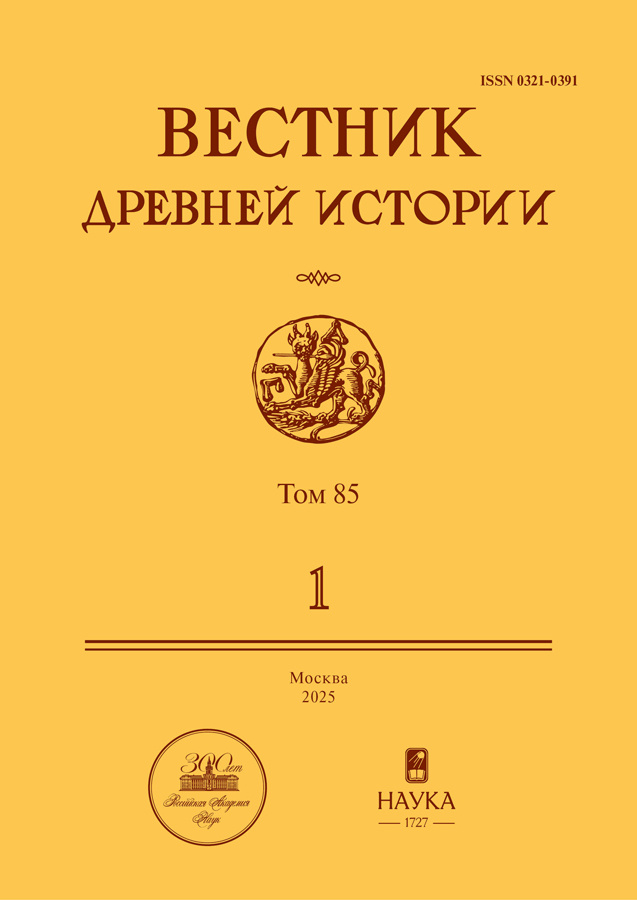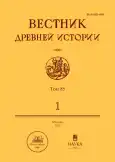Вестник древней истории
«Вестник древней истории» (ВДИ, англ. Journal of Ancient History, фр. Revue d'Histoire Ancienne), ISSN 0321-0391, – ведущий российский академический журнал, посвящённый истории древнего мира и смежным дисциплинам. ВДИ является старейшим научным историческим журналом, ныне выходящим в России, – он начал публиковаться осенью 1937 г. Издавался регулярно до марта 1941 г. (последний довоенный номер – № 1 за 1941 г.). В первое десятилетие существования публиковал также статьи по истории славян, Византии, Древней Руси. После перерыва на войну стал снова регулярно выходить по четыре номера в год с 1946 г.
С 1938 г. издается Институтом истории (с 1968 г. Институтом всеобщей истории) АН СССР (РАН) в издательствах: ОГИЗ (Соцэкгиз – Госполитиздат) – до ВДИ. 1941, № 1 (включительно), Издательстве АН СССР («Наука») – с ВДИ. 1946, № 1.
Главные (ответственные) редакторы журнала: А.С. Сванидзе (1937), А.В. Мишулин (1938–1948), С.В. Киселев (1949–1962), В.В. Струве (1962–1965), С.Л. Утченко (1965–1976), З.В. Удальцова (1976–1987), Г.М. Бонгард-Левин (1988–2008), А.И. Иванчик (с 2009).
В 1937–1947 гг. ВДИ имел французский подзаголовок Revue d’histoire ancienne и резюме на французском языке, с 1967 г. – английский подзаголовок Journal of Ancient History и резюме на английском языке.
Свидетельство о регистрации СМИ: № 0110170 от 04.02.1993
Текущий выпуск
Том 85, № 1 (2025)
ПАМЯТНИКИ СЕМЬИ *jj-пfr* ИЗ САККАРА И ИХ СУДЬБА
Аннотация
 5-17
5-17


«КУЛЬТОВЫЕ РЕФОРМЫ» ЦАРЕЙ ИУДЕИ В СВЕТЕ АРХЕОЛОГИЧЕСКИХ ДАННЫХ
Аннотация
 18–44
18–44


POST HOC ИЛИ PROPTER HOC? НЕКОТОРЫЕ РАЗМЫШЛЕНИЯ О СВЯЗИ МЕЖДУ ПРИНЯТИЕМ LEX IULIA DE CIVITATE И ВОССТАНИЕМ В ЭТРУРИИ И УМБРИИ В КОНЦЕ 90 г. до н.э.
Аннотация
 45–62
45–62


VIII чтения памяти М.И. Ростовцева
КЛЕРУХИЙ: АФИНЫ, МАКЕДОНИЯ И ЭЛЛИНИСТИЧЕСКИЕ ГОСУДАРСТВА
Аннотация
Этот очерк служит введением к четырем статьям на тему клерухий, посвященным памяти М.И. Ростовцева. Они призваны показать, что не только правовая основа, регулировавшая основание военных поселений в эллинистических царствах, была унаследована от Македонии (что, впрочем, не значит, что она была везде одинакова), но также и то, что существовал стандартный греческий архетип клерухии, о чем позволяет судить афинское постановление конца эпохи архаики относительно клерухии на о. Саламин.
 63–68
63–68


САЛАМИН: АРХЕОЛОГИЯ АФИНСКОЙ СИСТЕМЫ КЛЕРУХИЙ
Аннотация
Данная статья путем исследования процесса создания афинской клерухии на о. Саламин в конце архаического периода демонстрирует «археологию» системы клерухий. Обзор начинается с анализа позднеархаической надписи, которая устанавливает правила, применяющиеся к владельцам наделов в клерухиях. Затем, после краткого анализа войны между Афинами и Мегарой за обладание Саламином, рассматривается вопрос о происхождении рода Саламиниев и предлагается новое решение, связанное с обстоятельствами создания клерухий на Саламине. Статья завершается рассмотрением структурных и определяющих условий для создания клерухии.
 69–84
69–84


ПОЛИС И ЦАРСКАЯ ВЛАСТЬ НА БОСПОРЕ В ЭПОХУ СПАРТОКИДОВ: ЗЕМЛЯ, ГРАЖДАНСТВО И НАЛОГИ
Аннотация
В статье показано, что в Боспорском царстве с конца V в. до н.э. и до его подчинения Митридатом существовала государственная структура, не имевшая близких аналогов в греческом мире. Греческие полисы, включенные в состав царства, утратили свои гражданские институты, автономию и даже гражданство. Гражданство полисов было заменено общим боспорским гражданством, от которого, впрочем, сохранилось только название: граждане стали подданными. Все прерогативы полиса – начиная от права давать гражданство и кончая контролем финансов, регулированием торговли и законодательством – перешли к династии Спартокидов. Феодосия сохранила обособленный статус, но и там объем гражданских прав не отличался от боспорского. Клерухи существовали на Боспоре, но несли они обязательства непосредственно перед Боспорскими тиранами. Гражданские общины на Боспоре были заново созданы только Митридатом, который воспроизвел привычную ему политическую структуру: система автономных греческих полисов в составе эллинистической монархии. Можно предполагать, что эта политическая структура была унаследована Спартокидами от их предшественников Археанактидов, которые, по всей видимости, были ставлены никами Ахеменидов, покоривших Боспор ок. 480 г. до н.э. В подтверждение гипотезы о персидском контроле Боспора при Археанактидах, помимо уже приводившихся другими исследователями аргументов, приводится новый – определение баз колонн, обнаруженных на акрополе Пантикалея, как ахеменидских.
 85–108
85–108


КЛЕРУХИИ В ЭЛЛИНИСТИЧЕСКОМ ЕГИПТЕ
Аннотация
В представленной статье данные из недавно опубликованных папирусов объединены со сведениями из уже известных папирологических и эпиграфических источников, чтобы оценить современное состояние знаний о клерухии в эллинистическом Египте. Постепенно система, которая начиналась как способ поощрения элитной македонской кавалерии и укрепления их связи с новым местом жительства, распространилась на пехоту и различные чины полиции. С расширением интересов династии Птолемеев во II в. до н.э. этот институт стал более открытым, и наиболее влиятельные египетские семьи также стали получать наделы таким образом, по крайней мере, в Верхнем Египте, где царская власть постоянно находилась под угрозой. Мы видим, что члены таких статусных семей занимали важные посты не только в военной, но и в административной и религиозной сферах. Статья также обращает внимание на изменение локальных различий в фискальных отношениях между клерухиями и царской казной.
 109-119
109-119


РАЗДАЧА ЗЕМЛИ ЗА ВОИНСКУЮ СЛУЖБУ В ДРЕВНЕМ ЕГИПТЕ
Аннотация
Выделение земли солдатам существовало в древнем Египте долгое время. Уже с начала XVI в. до н.э., если не раньше, земля в Египте и, вероятно, также в Нубии иногда выдавалась демобилизованным египетским и иностранным солдатам в качестве награды за службу и, возможно, в качестве средства поддержки в период между военными кампаниями. Начиная с VII в. до н.э., некоторые земельные участки в Египте, по-видимому, содержали в себе прямое обязательство для их владельцев нести военную службу, когда объявлялся призыв. Эта система отличается от системы афинских клерухий VI–IV вв. до н.э., в которой воинские обязанности были связаны с гражданством. Вероятно, как египетские традиции, так и афинская система оказали влияние на систему клерухий при Птолемеях в Египте IV–II вв. до н.э., как предположил М. Ростовцев еще в 1941 г.
 120-132
120-132


Публикации
НОВЫЕ НАХОДКИ ФИГУРНЫХ СОСУДОВ РИМСКОГО ВРЕМЕНИ ИЗ ОКРЕСТНОСТЕЙ ХЕРСОНЕСА
Аннотация
 133–162
133–162


Из истории науки
РУССКИЙ АРХЕОЛОГИЧЕСКИЙ ИНСТИТУТ В КОНСТАНТИНОПОЛЕ И М.И. РОСТОВЦЕВ
Аннотация
 163–185
163–185


Критика и библиография
L . Per not. Confluences de la philosophie et de la rhétorique grecques. Paris, 2022
Аннотация
 186–198
186–198


 199–213
199–213


Научная жизнь
«Ломоносовские чтения» на кафедре древних языков и кафедре истории древнего мира исторического факультета МГУ имени М.В. Ломоносова (Москва, 26 марта и 1 апреля 2024 г.)
 214-217
214-217


ЕЖЕГОДНАЯ КОНФЕРЕНЦИЯ «ЦИВИЛИЗАЦИИ ДРЕВНЕГО БЛИЖНЕГО ВОСТОКА И АНТИЧНОСТИ: ИСТОРИЧЕСКАЯ ДИНАМИКА ОБЩЕГО И ОСОБЕННОГО» (Москва, 10–11 июня 2024 г.)
 218–228
218–228


Personalia
ЮБИЛЕЙ СЕРГЕЯ ГЕОРГИЕВИЧА КАРПЮКА
 229-230
229-230


Приложение
СИЛИЙ ИТАЛИК ОБ ОСАДЕ САГУНТА (ПУНИКА I. 271 – II. 707)
Аннотация
 231–268
231–268












